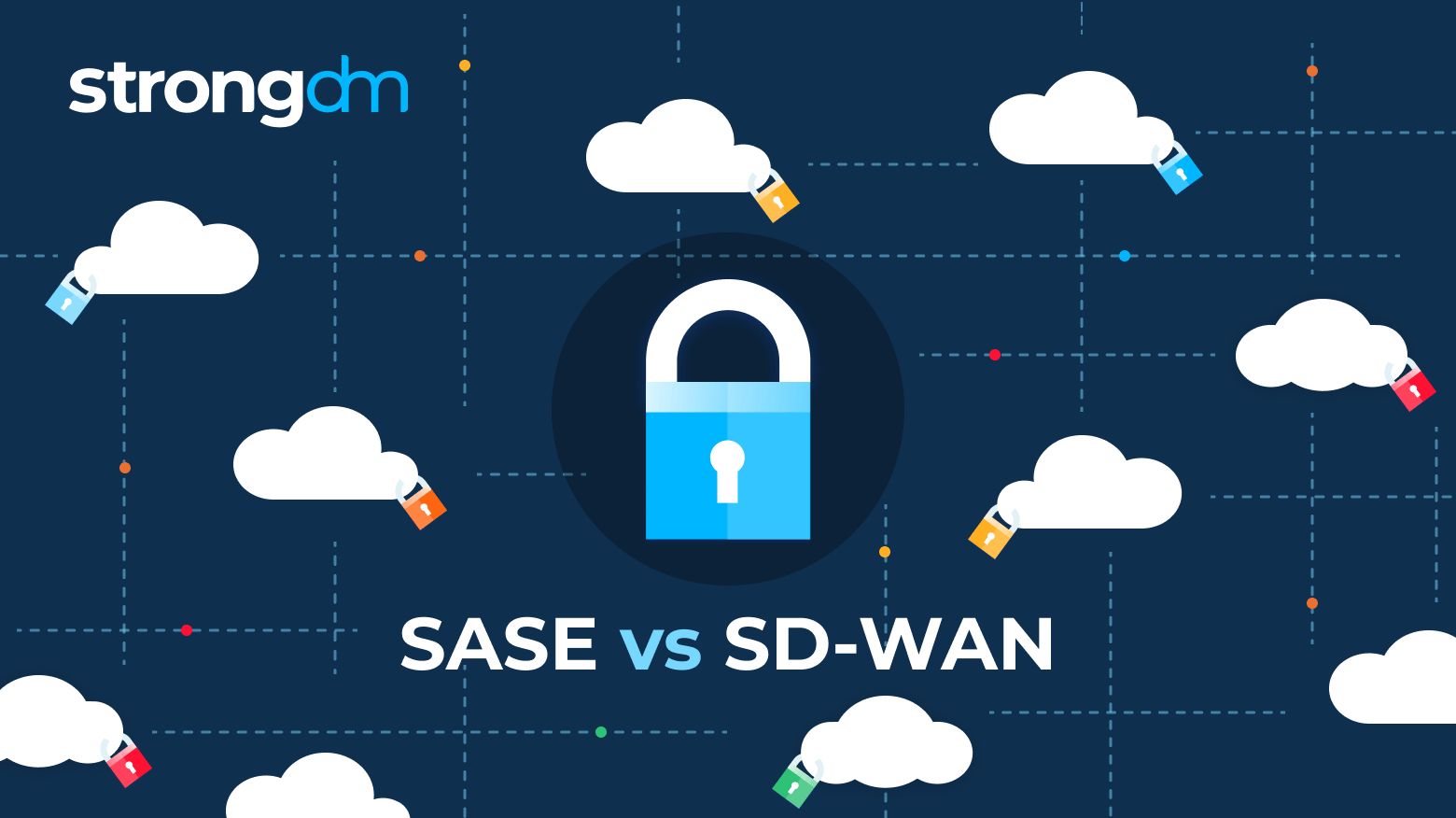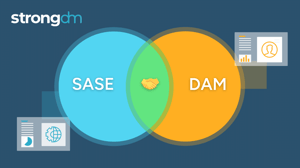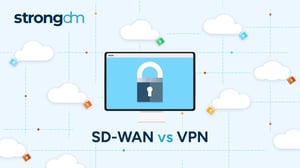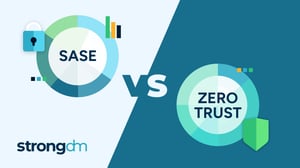SASE vs. SD-WAN: All You Need to Know


Written by
John MartinezLast updated on:
June 26, 2025Reading time:
Contents
Built for Security. Loved by Devs.
- Free Trial — No Credit Card Needed
- Full Access to All Features
- Trusted by the Fortune 100, early startups, and everyone in between
Summary: In this article, we'll look extensively at the cloud and security landscape then compare Secure Access Service Edge (SASE) with Software-Defined Wide Area Networking (SD-WAN). The cloud has been a game-changer for networking and security, having given rise to new, more agile ways of doing business. But the cloud has also created new challenges for security. Enterprises can no longer rely on perimeter defenses to protect their network because data now flows freely between users, devices, and applications in the cloud.
What are SASE and SD-WAN?
SASE and SD-WAN are two networking technologies intended to link geographically disparate endpoints to a data and software source. SASE combines SD-WAN capabilities with security and delivers them as a cloud service. Including both in a single platform helps reduce costs and increase efficiency by streamlining the management of networking and security functions.
Secure Access Service Edge (SASE)
Secure Access Service Edge (SASE) is an emerging security architecture that consolidates multiple network and security functions in a single, cloud-delivered service. It enables organizations to connect users to applications and data securely, regardless of their location or the type of device.
SASE represents a shift in how enterprises approach networking and security, moving away from traditional hardware-based solutions to a more flexible, software-defined approach. This allows organizations to take advantage of the many benefits of the cloud, including increased agility, reduced costs, and improved scalability.
Software-Defined Wide Area Network (SD-WAN)
SD-WAN is a software-defined approach to configuring and managing a wide area network (WAN). SD-WANs provide a more straightforward setup, better connectivity, and centralized management as compared to traditional WANs. SD-WAN is a virtualization technology that enables you to create a private network that spans multiple locations. SD-WANs are more adaptable and scalable than traditional WANs, enabling an increasingly mobile and remote workforce.
What’s the Difference Between SASE and SD-WAN?
SASE is a cloud-based network security solution, whereas SD-WAN is a network virtualization solution. SASE can be delivered as a service, making it more scalable and resilient than SD-WAN. Additionally, SASE offers more comprehensive security features than SD-WAN, including Zero Trust security and built-in protection against Distributed Denial-of-Service (DDoS) attacks.
Let's review more focused points on the differences between SASE vs. SD-WAN.
| SASE | SD-WAN | |
|---|---|---|
| Type of solution: | Cloud-based network security | Network virtualization |
| Focused on: | Security | Networking |
| Works with: | Any cloud service, including public, private, and hybrid clouds | Any WAN connection type, including Multiprotocol Label Switching (MPLS), broadband, and Long Term Evolution (LTE) |
| Connection: | Creates a secure connection from any user to any resource, regardless of location | Creates separate services for each location |
| Solution from: | Typically offered as a cloud-based service | Physical and cloud-native |
How Are SASE and SD-WAN Similar?
SASE and SD-WAN are cloud-based solutions that benefit organizations looking to improve their security and networking. You can use either solution with any cloud service or WAN connection. SASE and SD-WAN can connect branch offices to cloud resources, and both offer flexibility, scalability, and cost savings.
Each cloud solution offers many benefits, such as increased flexibility, scalability, and reduced costs. However, SD-WAN is typically better for small and mid-sized businesses because it offers them more control over their data and voice networks. SASE is better for larger organizations that need to manage large amounts of data traffic.
SASE may be the answer if your company is searching for a comprehensive cloud security solution. SD-WAN could be the way to go if you need a method to improve traffic flow across your hybrid WAN connection.
How to Choose the Right Tool for SASE and SD-WAN
The network edge is evolving. Enterprises are looking to adopt cloud-based models to improve agility, flexibility, and cost-efficiency. Here we'll explore some of the most important factors to keep in mind when making your decision.
- Deployment Model. Consider how you plan to deploy SASE or SD-WAN. There are two main options: on-premises and in the cloud.
You need on-site hardware to manage and operate on-premises SASE and SD-WAN. This gives you more control over the network but also increases complexity and cost.
The provider manages and operates cloud-based SASE and SD-WAN, leaving your IT team free to focus on other tasks. Cloud-based solutions are typically more scalable and easier to deploy than on-premises options. - Connectivity Requirements. What type of Internet connection do you need? How much bandwidth do you require? Do you need support for multiple links?
- Security Requirements. What type of security features do you need? Do you require support for advanced security protocols such as Internet Protocol Security (IPsec) or a Secure Socket Layer (SSL)?
- Management and Reporting Needs. How much control do you need over the network? Do you require detailed insights and reports?
- Budget. How much can you spend on a new solution? What will the long-term costs be?
By keeping these factors in mind, you can narrow down your options and find the perfect SASE or SD-WAN solution for your business.
SASE vs. SD-WAN: Frequently Asked Questions
Does SASE include SD-WAN?
While SD-WAN focuses on optimizing network traffic, SASE solutions include security features such as cloud firewalls and web filtering. SASE is an evolution of SD-WAN that offers a complete solution for managing hybrid and cloud networks.
Why is SASE the future of SD-WAN and security?
SASE is an evolving framework that addresses the challenges and issues with traditional security and network solutions like SD-WAN. With the rise of hybrid work and cloud adoption, traditional approaches to security and networks are no longer sufficient.
Perimeter-based security isn’t built for a distributed workforce and a remote world. This leaves organizations with disjointed security stacks and gaps in visibility vulnerable to an ever-expanding attack surface.
SASE offers a streamlined, integrated solution that addresses most network and security requirements at scale within a more efficient, manageable, and cost-effective model.
What is a SASE network?
SASE is a cloud architecture model that combines networking and security as a service to distribute network and security functions to clients through a single cloud-delivered platform. Organizations use SASE to improve remote access in an increasingly distributed workforce environment. SASE bridges the gaps that can occur when managing various siloed networks and security stacks.
SASE networks are becoming increasingly popular. A SASE network helps companies move their data and applications to the cloud by providing remote access and connecting data centers. It uses a combination of software-defined networking (SDN), cloud security, and edge computing to provide a secure way to connect users to data and applications.
What is SD-WAN replacing?
SD-WAN can replace traditional WAN solutions, such as Multiprotocol Label Switching (MPLS). MPLS is a data-carrying technology for high-performance telecom networks that are disconnected from physical links. SD-WAN separates networking hardware from the control mechanism, allowing you to simplify WAN management and operation.
While it offers many benefits over traditional WANs, SD-WAN is not without challenges. In particular, SD-WAN requires careful planning and design to ensure proper configuration and implementation. For this reason, SD-WAN solutions are often more expensive than traditional WANs and may not be available in all areas.
How StrongDM Can Help with SASE and SD-WAN
The cloud has become the new normal for business. Remote access and data center management have never been more important or complex. This is where StrongDM comes in.
StrongDM is a comprehensive infrastructure access platform that helps organizations take the next step in adopting a SASE model by natively supporting any database and networking tool in your environment. Manage and audit access to databases, servers, clusters, and web apps for automated, integrated, role- and attribute-based security no matter where your users are or what device they’re on.
Conclusion
The enterprise security landscape is intricate and challenging. Understanding how a cybersecurity solution can aid specific enterprise needs is key to staying safe in a digital environment. Enterprises will eventually abandon pure networking and security systems in favor of hybrid solutions which utilize SASE and SD-WAN integrations to handle new connections, devices, users, and locations.
Knowing the difference between SASE and SD-WAN cloud-based solutions helps you decide which one better suits your organization's needs. If you're looking for a comprehensive security solution, go with SASE. If you need to optimize traffic flow, go with SD-WAN.
Want to learn more? Get a no-BS demo of StrongDM.
Next Steps
StrongDM unifies access management across databases, servers, clusters, and more—for IT, security, and DevOps teams.
- Learn how StrongDM works
- Book a personalized demo
- Start your free StrongDM trial

Categories:

About the Author
John Martinez, Technical Evangelist, has had a long 30+ year career in systems engineering and architecture, but has spent the last 13+ years working on the Cloud, and specifically, Cloud Security. He's currently the Technical Evangelist at StrongDM, taking the message of Zero Trust Privileged Access Management (PAM) to the world. As a practitioner, he architected and created cloud automation, DevOps, and security and compliance solutions at Netflix and Adobe. He worked closely with customers at Evident.io, where he was telling the world about how cloud security should be done at conferences, meetups and customer sessions. Before coming to StrongDM, he lead an innovations and solutions team at Palo Alto Networks, working across many of the company's security products.
You May Also Like




